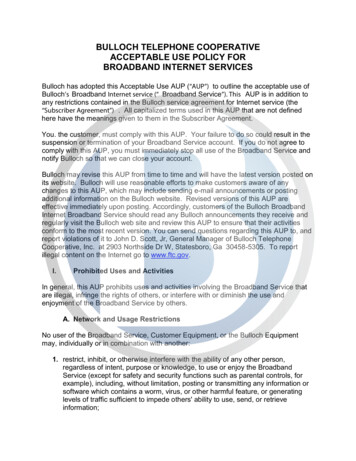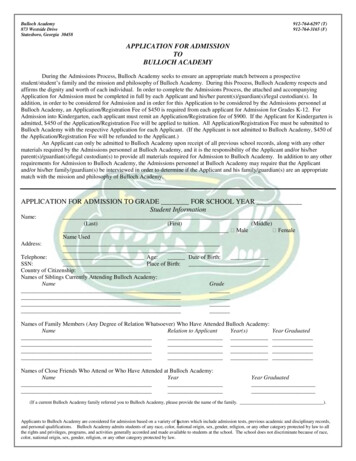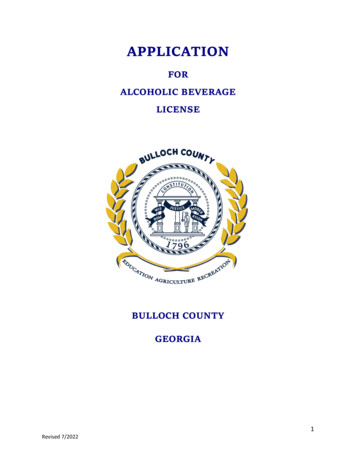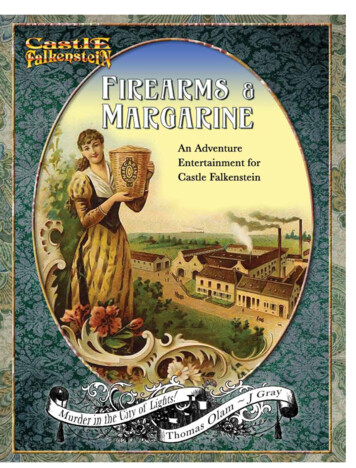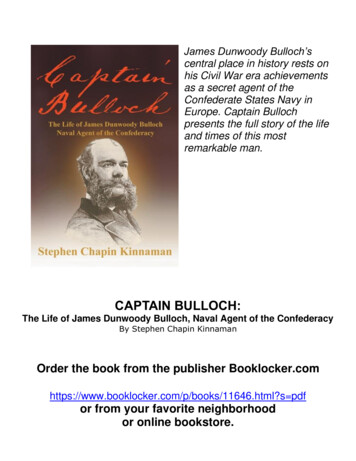
Transcription
James Dunwoody Bulloch’scentral place in history rests onhis Civil War era achievementsas a secret agent of theConfederate States Navy inEurope. Captain Bullochpresents the full story of the lifeand times of this mostremarkable man.CAPTAIN BULLOCH:The Life of James Dunwoody Bulloch, Naval Agent of the ConfederacyBy Stephen Chapin KinnamanOrder the book from the publisher 1646.html?s pdfor from your favorite neighborhoodor online bookstore.
Copyright 2013-2021 Stephen Chapin KinnamanChappell Hill, TexasISBN: 978-1-64719-471-0All rights reserved. No part of this publication may be reproduced, stored in aretrieval system, or transmitted in any form or by any means, electronic,mechanical, recording or otherwise, without the prior written permission of theauthor.Published by BookLocker.com, Inc., St. Petersburg, Florida.Printed on acid-free paper.BookLocker.com, Inc.2021Second Edition
TA B L E O F C O N T E N T SLIST OF OOK ONE: Son of SavannahAn Ancient and Honorable FamilySentiment More Tender than PlatonicThe Gentleman Who Was Judicially RobbedBOOK TWO: Life Afloat4I Have the Honour to Recommend Him5We Look Forward With Impatience to His Return6A Gallant Little Schooner7A Man of Science as Well as a Sailor8Everything is Perfectly Uncertain Connected With Him9This Is My Business; This I Do Not Consign10 Tell Him and His Lady Heaps of Howdy for Mevii2034527491111133152168187
viiiCAPTAIN BULLOCHBOOK THREE: War of the Rebellion11 I Want You to Go to Europe. When Can You Start?12 I Beg Command of the First Ship that Goes to Sea13 Every Aspiration of My Heart is Bound Up in Her14 Aide Toi et Dieu T’Aidera15 I Predicted A Glorious Cruise for the Dashing Little Craft16 If It Would Create Confusion Let Me Remain Here17 Greater Pain Than I Ever Conceived It Possible to Feel18 Far More Formidable Than Anything Yet Attempted232252273294315335357380BOOK FOUR: Exile in England19 I Have Become Greatly Attached to This Country20 I Enjoy the Dear Old Fellow More Than I Can Tell21 Abide In The Hope Which Springs Eternal404423440EPILOGUEEND NOTESBIBLIOGRAPHYINDEX455467525547
L I S T O F I L L U S T R AT I O N SNo. 1No. 2No. 3No. 4No. 5No. 6No. 7No. 8No. 9No. 10No. 11FAMILY TREE AND MAPS (pp. 5 to 17)Bulloch Family TreeGeorgiaCity of SavannahU. S. Eastern SeaboardThe Brazil StationThe Mediterranean StationThe Pacific StationMouth of Columbia RiverThe United Kingdom and FranceApproaches to LiverpoolThe Merseyside AreaNo. 1No. 2No. 3No. 4No. 5No. 6No. 7IMAGES AND PAINTINGS (pp. 209 to 229)Major James Stephens Bulloch1837 View of SavannahBulloch HallSloop of War at Charlestown Navy YardThe Steamship Black WarriorCommander James Dunwoody BullochNo. 10 Rumford Placeix
xNo. 8No. 9No. 10No. 11No. 12No. 13No. 14No. 15No. 16No. 17CAPTAIN BULLOCHBirkenhead IronworksC.S.S. AlabamaH.M.S. Scorpion and H.M.S. WivernC.S.S. StonewallThe Bulloch BrothersJames Dunwoody BullochTheodore RooseveltHon. James Bulloch.Lieut. James D. BullochStuart Elliott and Martha Louise Bulloch
CHAPTER 4I Have the Honour to Recommend HimTNAVY TO which James Dunwoody Bulloch now belongedwas nearly indistinguishable from the Navy that had won considerable fame during the War of 1812, and only marginally differentfrom the Continental Navy established at the birth of the UnitedStates. Frigates were the principal warships at the core of the Navy’scruising squadrons. The U.S.S. Constitution—‘Old Ironsides’—wasstill in active service and would remain so for another twenty years.Every ship in the United States Navy of 1839 was a wooden sailingship save one, the coastal steamer Fulton II, and she was used onlyfor experimental gunnery trials. In November of that same year, Secretary of the Navy James K. Paulding submitted his Annual Report,which proposed funding for the manning and commissioning of oneship-of-the-line, six frigates, nineteen sloops-of-war, seven smallervessels (brigs and schooners), and one steamer.1 Setting the tone wasPresident Martin van Buren, who suggested that United Statesneeded “no navy at all, much less a steam navy.” Secretary Paulding,a man who fancied himself a writer, responded to suggestions theNavy should exhibit more progressive thinking by exclaiming “I ambeing steamed to death!” Curious attitudes, indeed, from the leadersof a nation whose merchant marine then possessed over seven hundred steam-powered vessels.2If the United States Navy was behind in its application of technology, the same could not be said about its traditions of service andHE74
I Have the Honour to Recommend Him75global scope of operations. Many of the same officers who madetheir names in the War of 1812 were still active: John Rodgers, IsaacHull and Charles Morris to name a few. And the extent of the Navy’soperations was truly world-wide, with six squadrons on simultaneousservice in the Mediterranean, off the coast of Brazil, in the WestIndies and Gulf of Mexico, throughout the Pacific Ocean, in the‘Indian and China Seas,’ and off the coast of Africa. On top of this,Lieutenant Charles Wilkes’ South Seas Exploring Expedition hadjust commenced its four year voyage of discovery, probing theexpanses of the Pacific and Antarctic regions. The Navy was also anactive participant in the Coast Survey, with its officers and shipsinvestigating and charting the coasts and harbors of the UnitedStates.The inspiration of its officer corps notwithstanding, officer training was another area where the Navy of this era needed a more progressive vision. Newly appointed midshipmen, such as JamesDunwoody Bulloch, were immediately sent on board warships andwere expected to learn their profession on the job. The largest shipscarried chaplains, school masters and even professors who instructedthe young middies, but for the most part it was a captain’s mentoring—for better or worse—together with the midshipman’s own nativeability that trained the future officer. A lyceum at the Brooklyn NavyYard to promote the education of young officers had been recentlyestablished, but it was just a library, lecture hall and a quiet room forself-directed study. The Navy’s approach was in sharp contrast to theArmy which since 1802 had been systematically educating its youngcadets at the United States Military Academy at West Point, NewYork. Recall the invitation James Stephens Bulloch had received twoyears before to attend cadet examinations at the Military Academy; inthis area, the Navy lagged behind its land-based counterparts.Officers of the Navy were beset by another problem, the lack ofopportunity for advancement. During the long period of peace thatfollowed the War of 1812, the size of the Navy remained more or lessconstant. As its core of senior officers continued in active serviceand without the stress of war to create new openings, the inevitableoccurred: stagnation of promotions. Further exacerbating the situation was that during these years no higher rank than captain existed,a commodore being only the honorific title for a commander of asquadron. Many younger officers encountered long intervals
76CAPTAIN BULLOCHbetween active service afloat and were forced to develop alternatecareers to remain solvent. Raphael Semmes, the future captain ofAlabama, is a good example of this phenomenon; he practiced lawwhen not at sea. Despite the bleak career outlook, a life of a navalofficer still had strong appeal. The number of applicants farexceeded the midshipmen slots available and considerable patronagewas required to obtain an appointment. In this light, James StephensBulloch’s successful and timely efforts on behalf of his son come intosharper perspective.In summary, the Navy to which James Dunwoody Bulloch hadpledged his allegiance was a service widely admired at home andabroad for its emerging professionalism. It was also a service which,in little more than sixty years of existence, had created legendary traditions and a proud heritage. But it urgently needed reform in anumber of key areas. The age of steam power was underway andwould soon be followed by the introduction of the shell gun, ironshipbuilding, and in just twenty more years, armored warships. TheNavy of the future could no longer remain the Navy of the past. Torespond to these developments, it needed a well educated officercorps, one that was motivated to meet the demands that lay ahead.Sixteen year old James Dunwoody Bulloch was just beginning anactive naval career that would embrace the entirety of this challenge.* * *Things moved slowly at first for James Bulloch. Although he hadaccepted his midshipman’s appointment in late June, it wasn’t until 2September 1839 that he again wrote the Navy stating that he wasready for “any service” and solicited orders. It is of note that his letter was addressed from Lebanon, Georgia. At that date the postoffice nearest Roswell was at Lebanon Mills, some one and a halfmiles distant. This indicates that following his appointment, youngJames had left Savannah and was able to spend time with his familyin Roswell before embarking on his career in the Navy. It was wellthat he did for over four years would pass before he was home again.3James Dunwoody Bulloch soon received orders from the Navydated 13 September 1839, instructing him to report to CommodoreDownes at Boston for duty on board the frigate United States. Downeswas the commandant of the Charlestown Navy Yard which lay deepwithin Boston harbor. There United States was just completing a
I Have the Honour to Recommend Him77major repair, preparing for sea under the command of CaptainLawrence Kearny. Now that James Bulloch had received orders for“actual service,” he could start drawing his pay of 350 per year.4 ForMidshipman Bulloch it was a heritage-laden introduction to theUnited States Navy. Charlestown Navy Yard, within sight of BunkerHill and across the Charles River from Boston and its Faneuil Hall—the cradle of American liberty—was one of the nation’s first six Navyyards, being established in 1800. It was also the site of New England’s first naval drydock.5The venerable United States possessed an even richer history. Oneof the original six frigates authorized by the landmark 1794 bill ‘toprovide Naval Armament,’ she was the first afloat, launched inPhiladelphia on 10 May 1797. The 44 gun frigate distinguished herself during the War of 1812 when, under Captain Stephen Decatur,she captured the British frigate Macedonian.6 United States laterbecame widely known to American readers when one of her sailors,Herman Melville, published a harsh but highly descriptive account ofa Pacific cruise of hers in a book titled White-Jacket; or, The World ina Man-of-War. She was a large ship, one of the Navy’s super-frigateswhich were designed to be fast enough to out sail anything theycouldn’t beat. Her hull’s length between perpendiculars was 175 ft,with a beam of 43 ft 6 in and a draft of 23 ft. Her full load displacement was 2,200 tons, the same as a large World War II destroyer. Andshe was driven by sail power alone, setting a total thirty-six sails witha combined area of 42,720 square feet, or nearly an acre.7 Duringtime of war, her crew numbered almost 450 men, but on peacetimecruises she made do with a somewhat smaller compliment. A frigateof this era was one of the most complicated ‘machines’ man had yetdevised, and every one of her officers and crew were needed to effectively maintain, sail and fight the ship.On 26 September, Acting Midshipman Bulloch commenced dutyon United States. Considering the times and distances, this datereflects a remarkably quick journey from frontier Roswell to distantBoston; perhaps he was lucky enough to catch a fast packet sailingdirect from Savannah to Boston. It was now fall and presumablyJames Bulloch, having spent two years in nearby Hartford, wasaccustomed to New England’s cooler weather. After reporting toCaptain Kearny for duty, Bulloch (now’s a good time to start callinghim only by his surname) quickly settled into his new quarters.
78CAPTAIN BULLOCHMidshipmen on frigates were berthed in the ‘cockpit,’ a crampedspace on the ship’s lower deck immediately forward of the officer’sward room. It was below the gun deck and therefore without directnatural lighting. All of his clothing and possessions would have beencrammed into a sea chest, which was stowed in the cockpit togetherwith his fellow midshipmen’s sea chests, hammocks and other sundrypossessions. When the ship ‘beat to quarters’ in anticipation of a battle, the cockpit was quickly transformed into the surgeon’s station,and all the midshipmen’s sea chests grouped together and coveredwith canvas to form an impromptu operating table. Midshipmen,being young males in their late teens, had a reputation for rowdybehavior, prank playing, and rough-housing. For a newcomer, it wasa tough, uphill fight—sometimes quite literally—to win respect fromthe established denizens of the cockpit. A ship is a very small placeand once on board, there was no escape or privacy; a young officerquickly learned to vigorously defend his honor, and to be equally vigorous in avoiding giving unnecessary offense.A midshipman was expected to master the myriad academic disciplines necessary to competently sail a ship—navigation, mathematics, trigonometry, and astronomy. He needed to fully understand hisship’s log book entries, read sea charts, determine compass variation,plot a course, and master the skills required for dead reckoning aship’s position. The fine points of naval etiquette were also part ofhis curriculum, such as signaling and saluting other ships, and greeting visiting dignitaries. Mastering the huge fund of naval customs,law of the sea and lore of the service was a discipline in itself; andthen there was what the Navy calls its ‘lucky bag’ of facts and traditions, which every midshipman was expected to know by heart. Ontop of his academic burdens, an acting midshipman also had to master all the skills possessed by sailors. The rough and dirty businessof reefing a sail, splicing a rope, and handling the great guns neededto be quickly learned. Midshipmen were often sent on special dutiesin the ship’s boats—filling water casks or boarding other ships—which provided a perfect training ground for the basics of seamanship. The many ship handling evolutions described in Darcy Lever’sThe Young Sea Officer’s Sheet Anchor were a vital part of a midshipman’s training. He needed to know how to clear the hawse, unmoorthe ship, get way on her, cat the anchor, set sails in the proper order,and to trim them to best effect using the ship’s nearly two miles of
I Have the Honour to Recommend Him79running rigging. And then there were the repair and emergencydrills—such as shifting a topmast, sending down spars, replacingshrouds, hoisting out a boat, and many other tasks—that wereexpected to be coolly performed when the ship was in combat.A midshipman stood watches as appointed by the ship’s first lieutenant. Midshipmen were typically detailed to superintend andassist various activities. For example, one was stationed in each ofthe ship’s three tops when sails were being furled. They stood by tohelp clear the braces and bowlines when the ship was tacked, theymustered men to their stations, and they watched as the hands stowedtheir hammocks. They were slaves of the lieutenants and weretasked with running errands and performing jobs of all kinds, alwayswith the utmost zeal and respect. However, given their unique placein ship’s hierarchy, midshipmen were in a potentially tricky position:as the most junior of officers, they were subject to the orders andwhims of all their senior officers, yet as officers themselves they inturn commanded the vast majority of the men on the ship—theenlisted sailors. Thus while a midshipman could be ‘mast-headed’—sentenced to spend the night at the top of the main mast—by alieutenant for his slack performance, a young middy could order thepunishment of an able seaman old enough to be his father. Withinthe Navy’s arcane hierarchy of rank, the fundamental elements governing human behavior were sorely tested: respect for others, competence, and above all, sound judgment. And together with theiracademic knowledge and practical skills, midshipmen were expectedto always be gentlemen. The Navy’s administration well understoodthe complex challenges incumbent on these young men. The UnitedStates Naval Regulations of 1818 gave instructions that “The commanding officers will consider the midshipmen as a class of officers,meriting in an especial degree their fostering care.”8 How much andof what quality of “fostering care” they received was, of course,entirely dependent on the ship’s captain.* * *Bulloch’s service on the frigate United States was relatively short.In early 1840 the old frigate made a cruise down the east coast during which she touched at New York City. Her destination was Norfolk, Virginia, nearby the Gosport Navy Yard. Once safely anchored,the ship’s officers and crew were then transferred to the newer and
80CAPTAIN BULLOCHlarger frigate Potomac which was fitting out for service. TheGosport Navy Yard, now known as the Norfolk Naval Shipyard, wasthe oldest and largest such facility in the United States. An established shipyard since the days when Virginia was a colony, theGosport Navy Yard had made history just seven years before whenthe 74 gun ship-of-the-line Delaware entered its new graving dock,the first ship so docked in the Western Hemisphere.9 Bulloch wouldagain visit the Gosport Navy Yard during his naval career, and beforereturning to his home in Georgia, he would serve on the mightyDelaware.The records indicate Bulloch was formally transferred fromUnited States to Potomac on 31 March 1840.10 The first entry inPotomac’s log book for her upcoming cruise is dated 14 April 1840;her commanding officer was the familiar Lawrence Kearny, Esq. On13 May it was recorded that all hands were called to up anchor.11Potomac was now underway to Rio de Janeiro where she wouldbecome the flagship of the Brazil Squadron. The first of the ‘Gradual Increase’ frigates authorized after the War of 1812, dimensionallyPotomac was only slightly larger than United States, being 1 ft 6 ingreater in breadth and two inches deeper in the hold. However shewas arranged as a true double-banked ship, with two complete gundecks and approached the firepower of contemporary 74 gun shipsof-the-line. She could mount more than her rated forty-four guns,carrying at times a maximum of fifty-two guns. She was also a muchnewer ship than United States, having been commissioned fewer thannine years before. Her cruise to Brazil would be her third overseasdeployment.12The Brazil Squadron, sometimes called the South AtlanticSquadron, had been a U.S. Navy staple since 1826. It was establishedin response to a war between Brazil and Argentina, and continued itspresence in those waters to protect American interests during theyears of unrest that followed. In 1840 Brazil was relatively stable,being governed by a regency in the name of the future Emperor DomPedro II. However, affairs in the countries bordering the River Platewere another matter. Before and after the period of Bulloch’s servicein the Brazil Squadron, what is now modern Uruguay, together withArgentina, were embroiled in what became known as the ‘GuerraGrande.’ The French were enforcing a rigid blockade of the newArgentine government, all of which compelled the United States to
I Have the Honour to Recommend Him81augment its forces in those waters. Thus the squadron exhibited apattern of cruising between the principal ports—also the capitals ofthe three nations—namely Rio de Janeiro in Brazil, Montevideo inUruguay, and Buenos Aires in Argentina. Rio de Janeiro was thesquadron’s anchorage of choice for several reasons. First, it is theclosest of the three ports to the United States. Second, its strategiclocation astride the trade routes around South America and Africameant that it was frequently visited by the ships of all nations sailingto and from the Pacific or Asia. And third, Rio de Janeiro was andstill is one of the finest, most beautiful ports on the world, offering asecure, sheltered harbor with a mild, temperate climate the yeararound.In the course of her voyage to Brazil, Potomac crossed the equatorand into the Southern Hemisphere. This would have marked Bulloch’s first transit of that hallowed latitude; one wonders if Neptune’scourt received him and the ship’s other ‘pollywogs’ with the traditional and humiliating ceremony of initiation. Two and a half monthsafter her departure from Norfolk, Potomac sailed into Rio de Janeiro.Her log book, under the date of 4 July 1840, contains the followingentry:From 8 to Midnight At 11 came to with the Larboard anchorin 15 fathoms of water in the Harbor of Rio. At 11:40 Commodore Charles G. Ridgley, Commanding the station, visitedthe Ship and was saluted with 13 guns simultaneously with thesalute the Broad Pendant was hoisted at the Main Mast head andhauled down on board the Sloop of War Decatur, which shipand the Brig of War Enterprise continued the salute with thesame number of guns each.13On 21 July, Potomac was again on the move. Her log reports thatshe “made sail got underway and stood out of the harbor under Royals.” The sight of the huge frigate ghosting out of Rio’s crowded harbor under a 200 ft high cloud of canvas must have been spectacular;it also exhibited the flawless seamanship of her officers and crew. Itwasn’t until the last day of September that she cast her anchor again,this time in the roadstead of Montevideo. During her stay, the RoyalNavy’s Admiral Sir William King visited the ship and was salutedwith thirteen guns. These brief descriptions of Potomac’s first twoport calls set the pattern for many more to come: frequent visits by
82CAPTAIN BULLOCHforeign dignitaries, all saluted copiously by gun fire. Acting Midshipman James Bulloch had now been a naval officer for over a year,and with each day was gaining more and more valuable experience.Considering the ports frequented by the Brazil Squadron, two ofthem in Spanish-speaking countries, his lessons in Spanish no doubtproved their value.* * *On 18 January 1841, Potomac was again underway together withtwo other warships of the Brazil Squadron, the sloop-of-war Decaturand the brig Enterprise.14 James Bulloch’s original appointment in1839 as an acting midshipman was conditional in that he was “to bewarranted from date of appointment if recommended by his commanding officer after six months’ actual service at sea.” Receipt ofa midshipman’s warrant was the first step in Bulloch’s careeradvancement in the Navy, and near the end of January he requestedthe commander he had served under since first reporting for duty,Lawrence Kearny, to write him a recommendation. Kearny complied and signed his name to the following letter, addressed to thesecretary of the navy:U.S. Ship PotomacAt Sea, Coast of BrazilJanuary 29th 1841Sir:Acting Midshipman James D. Bulloch, of this vessel, havingserved under my immediate orders for and during the presentcruise, I have the satisfaction to state that during the time, his conduct has been that of a zealous, active and attentive young officer;and I have the honour to recommend him as one possessing thosequalifications that entitle him to your consideration and favour onhis applying for a Warrant.I am, very respectfullyYour Obt. ServantLawrence KearnyCaptain15Kearny’s letter is a model of brevity: its single sentence says anenormous amount. Bulloch himself wrote the next day to the secretary, forwarding Kearny’s recommendation under cover of a letter ofhis own:
I Have the Honour to Recommend Him83ToThe HonorableThe Secretary of the NavySirI have the honor to inclose [sic] to you a letter from CaptainKearny, my commanding officer, recommending to your consideration my application for a warrant as Midshipman. I nowmake respectful application for a warrant & should it meet yourapprobation would be glad to receive one.I am with great respectYour Obedient ServantJames D. BullochActing Midn U.S. Navy16Together the two letters achieved their intended effect; “Jas. D.Bulloch” was recorded as being warranted as a midshipman on 8April 1841.17 This was an important step in Bulloch’s careeradvancement. He was no longer an ‘acting’ midshipman; he now hada warrant as an officer of the United States Navy. It was well thatBulloch obtained Kearny’s recommendation when he did, for by 2February, Potomac was again in Rio de Janeiro. One week later Captain George W. Storer assumed command of the frigate; Kearny hadbeen appointed commodore of the East Indies Squadron, hoisting hispennant on its flagship, the 38 gun frigate Constellation. The Navy,then as now, never keeps anyone in the same place for very long.Midshipman Bulloch had his first brush with royalty during thissame month. Potomac’s log entry of 18 February 1841 tells thestory:Dom Pedro Emperor of Brazil and his suite came alongside thisship where they were received by all the officers of the ship onthe Quarter Deck. His Majesty stopped on board 15 minutesand left the ship at 3:20. Manned the yards and saluted him with3 cheers and 21 guns.18During the remainder of 1841, with the exception of a short, twoweek cruise in mid July, the U.S.S. Potomac remained at anchor for afull twelve months in Rio de Janeiro. It is no surprise that reports ofanchor chain corrosion were recorded in July. It’s also of interest thatthe coronation of Brazil’s Emperor Dom Pedro II occurred during
84CAPTAIN BULLOCHPotomac’s brief cruise; perhaps her new captain thought it best thathis ship put to sea lest his crew be tempted by the spirited celebrations.Just because Potomac wasn’t under sail and cruising, doesn’t meanher men were idle. The ship’s log book is replete with activities,among which were sending working parties ashore, clearing theship’s hawse (anchor cables becoming crossed), and towing otherwarships—foreign as well as U. S Navy—in and out of Rio’s harbor.American merchantmen touching at Rio de Janeiro were also routinely boarded by Potomac’s young midshipmen, their paperschecked, and particulars of their voyages recorded. A sampling ofher boarding parties’ results from this period provides a marveloussnapshot of the worldwide reach of America’s commerce:Brig Helen McLeod 70 days from PhiladelphiaWhale ship Carrova 81 days from New ZealandBrig Himmileah of New York, 30 days from Loango, coast of AfricaBrig Fabius 59 days from BaltimoreBarque J. S. Waln, 60 days from BostonBrig Tweed 70 days from BaltimoreShip Azelia 62 days from New YorkShip John N. Gosher 36 days from ValparaisoShip Sobiski 64 days from BucksportBarque Globe 9 days from PernambucoBrig Montezuma 56 days from BaltimoreBarque Brothers 50 days from NorfolkBarque Baltimore 38 days from Cadiz 19Sometime in this period Bulloch would have received a letter fromhome bringing sad news: the death of his young half-brother, CharlesIrvine Bulloch. The boy’s life was tragically short, just two years andnine months.20 Bulloch had known Charles Irvine for only thebriefest time, last seeing his brother during his final visit to Roswellbefore leaving for naval service. It must have tugged at Bulloch’sheart to read of a death in the family, being so far away and unable tooffer condolences or openly mourn.Near the end of Potomac’s long port stay, Commodore Ridgley,who had commanded the Brazil Squadron since its departure fromNorfolk in spring of 1840, relinquished his command for reasons ofill health. He sailed in the homeward bound frigate Constitution—
I Have the Honour to Recommend Him85‘Old Ironsides’ herself—departing Rio de Janeiro on 15 September1842. In his absence, Potomac’s Captain Storer was temporarily incommand of the squadron.Midshipman James Bulloch had now been in active naval servicefor two years, virtually all of it at sea. How time flies! One wondersabout the details of his life during these years: how he kept hisclothes in order, what he read, if he was ill or injured, how often hewrote or received letters, and his relations with his fellow officers.Was he happy in his decision to become a naval officer? And whatdid he look like? Aside from his cryptic passport description, itwould be nearly twenty more years until a photograph of James Dunwoody Bulloch was taken which has survived. It shows an unremarkable man of medium height and build, with lanky dark hairalready receding. His chin is shaved but the remainder of his face iscovered by whiskers in the popular ‘mutton chop’ style of the day.He exhibits a broad forehead and a mouth which is strongly reminiscent of Theodore Roosevelt’s. His expression is one of studied intensity and thoughtful contemplation.* * *The Brazil Squadron’s new commodore, Charles Morris, arrived inRio de Janeiro on 12 December 1841 on board the U.S.S. Delaware,which came to smartly that afternoon on Potomac’s larboard quarter.Both flagship and commodore bespoke a more muscular Americanpresence in South Atlantic waters. Charles Morris, now one of theNavy’s senior and most revered captains, had served as the executiveofficer of the U.S.S. Constitution during her famous defeat of theBritish frigate Guerriere. Severely wounded in that action, Morriscontinued in active service, becoming a Board of Navy commissioner in 1823.21 Delaware was one of the Navy’s very few ships-ofthe-line in active commission. Rated at 74 guns, this battleship waspierced for 102 guns and could throw a broadside of over 1,700pounds. She was huge by any measure: length 196 ft 3 in, breadth53 ft, depth of hold 21 ft 8 in, and a displacement of 2,633 tons. Hermain mast towered 230 ft above her waterline; from the extremity ofher jib boom to her ringtail boom, she stretched over 380 ft. Hercrew numbered more than 800 and she was the equal to nearly anyother warsh
LIST OF ILLUSTRATIONS FAMILY TREE AND MAPS (pp. 5 to 17) No. 1 Bulloch Family Tree No. 2 Georgia No. 3 City of Savannah No. 4 U. S. Eastern Seaboard No. 5 The Brazil Station No. 6 The Mediterranean Station No. 7 The Pacific Station No. 8 Mouth of Columbia River No. 9 The United Kingdom and France No. 10 Approaches to Liverpool No. 11 The Merseyside Area IMAGES AND PAINTINGS (pp. 209 to 229)


